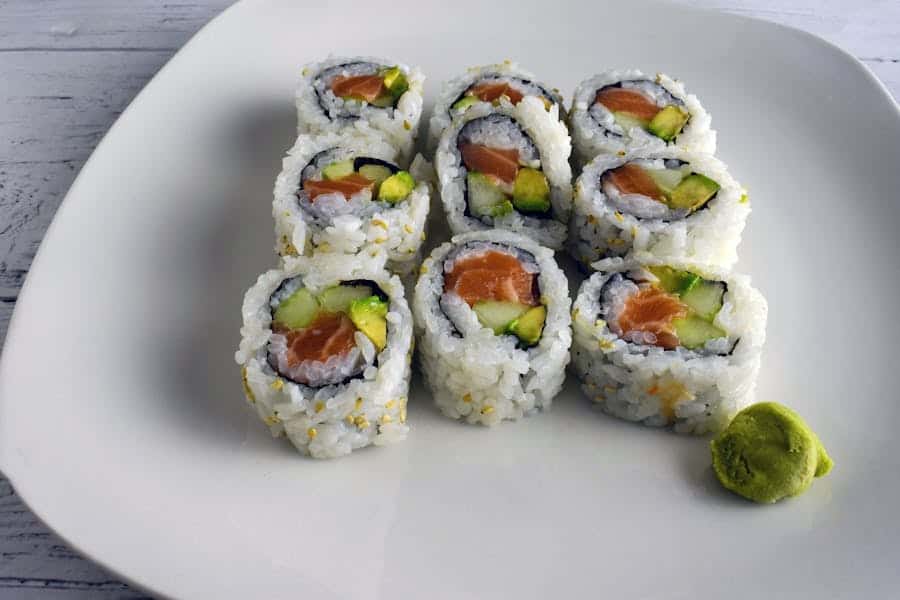Sushi, a traditional Japanese dish, has gained immense popularity across the globe, captivating the taste buds of food enthusiasts everywhere. Among the myriad sushi varieties, the California Roll stands out as a particularly beloved and iconic creation. This unique roll is a fusion of Japanese culinary art and Western tastes, making it a staple in sushi restaurants worldwide. The purpose of this article is to delve into the intriguing world of the California Roll, exploring its ingredients, history, and preparation method. We aim to uncover why it resonates so strongly with a diverse audience and how it has become a symbol of culinary innovation and cultural exchange.
What Is In A California Roll?
A California Roll typically contains imitation crab (surimi), avocado, and cucumber, all wrapped in sushi rice and nori (seaweed sheet). It is often garnished with sesame seeds and may be rolled “inside-out,” with the rice on the outside. This roll is known for its mild flavor and creamy texture, making it a popular choice for those new to sushi.
The History Of The California Roll
The California Roll is believed to have been invented in the 1960s in Los Angeles, California. Chef Ichiro Mashita, working at the Tokyo Kaikan sushi restaurant, is often credited with its creation. At the time, sushi was still a relatively novel concept in the United States, and traditional ingredients like tuna and fatty toro were hard to come by. Seeking a substitute that would appeal to American palates, Mashita experimented with different ingredients, ultimately landing on the combination of avocado, crab, and cucumber.
The introduction of avocado was a game-changer. Its creamy texture and rich flavor somewhat resembled toro, making it an excellent substitute. Additionally, Mashita found that using avocado helped to counterbalance the stronger flavors of the seaweed and was more palatable to the local clientele. The use of imitation crab, or surimi, also made the roll more accessible and affordable, further increasing its popularity among Americans.
As the popularity of the California Roll grew in the United States, it began to make its way back to Japan and other parts of the world. The roll underwent various transformations, with chefs adding their own twists and ingredients. Despite these variations, the core elements of avocado, crab, and cucumber remained. The roll’s popularity helped to pave the way for other types of fusion sushi, blending traditional Japanese techniques with local flavors and ingredients.
Today, the California Roll is recognized as a staple of American sushi cuisine and has become a symbol of the successful fusion of Japanese and Western culinary traditions. It played a significant role in popularizing sushi in the United States and around the world, acting as a gateway for many to explore other types of sushi and Japanese cuisine. The California Roll’s history is a testament to culinary innovation and adaptation, and its enduring popularity highlights its appeal across diverse cultures and tastes.
Why Is The California Roll Popular?
The California Roll has gained widespread popularity due to several key factors:
- Accessibility And Approachability: One of the primary reasons for the California Roll’s popularity is its accessibility. It is widely available in sushi restaurants, supermarkets, and even convenience stores, making it easy for people to try. Its ingredients are familiar and less intimidating than raw fish, which appeals to those who are new to sushi or hesitant about trying traditional Japanese sushi with raw ingredients.
- Appeal To Western Palates: The California Roll was specifically designed to cater to Western tastes. The use of cooked imitation crab and creamy avocado, combined with the mild flavor of cucumber, creates a taste profile that is more familiar and appealing to those not accustomed to eating raw fish. The roll’s flavors are gentle and well-balanced, making it an excellent introduction to sushi for the uninitiated.
- Innovative And Versatile: The California Roll is seen as a symbol of culinary innovation. It was one of the first sushi rolls to deviate significantly from traditional Japanese sushi, incorporating non-traditional ingredients and an inside-out roll technique (rice on the outside). This innovation laid the groundwork for a multitude of other fusion sushi rolls and has inspired chefs to experiment with new combinations and flavors.
- Visual Appeal: The California Roll is often presented with rice on the outside, coated with sesame seeds or tobiko (fish roe), which adds to its visual appeal. The contrasting colors and textures make it not only tasty but also aesthetically pleasing, attracting diners who enjoy dishes that are as beautiful as they are delicious.
- Dietary Versatility: The California Roll can easily be adapted to suit various dietary needs. For example, it can be made without any animal products for vegetarians by substituting imitation crab with additional vegetables. This flexibility has helped broaden its appeal to a wider range of dietary preferences and restrictions.
How Is A California Roll Made?
Making a California Roll involves a series of steps that combine traditional sushi-making techniques with specific ingredients unique to this roll. Here’s a step-by-step process:
Preparation Of Ingredients:
- Imitation Crab (Surimi): Surimi is typically pre-cooked and ready to use. It’s either shredded or cut into thin strips.
- Avocado: The avocado is peeled, pitted, and sliced into thin strips.
- Cucumber: The cucumber is washed, and the ends are trimmed. It’s then cut into long, thin strips, with the seeds often removed to prevent excess moisture.
- Sushi Rice: Sushi rice is prepared by cooking short-grain rice and then seasoning it with a mix of rice vinegar, sugar, and salt. The rice must be cooled to room temperature before being used for rolling.
Preparing The Nori (Seaweed Sheet):
A sheet of nori is placed on a bamboo sushi mat, shiny side down. For an inside-out roll (rice on the outside), the nori sheet is partially covered with a thin layer of sushi rice and then flipped so the rice is on the bottom.
Layering The Ingredients:
On the nori, the ingredients (imitation crab, avocado, and cucumber) are laid out in a line along one edge. Care is taken to distribute the ingredients evenly for a balanced flavor and texture in each bite.
Rolling The Sushi:
Using the bamboo mat, the edge of the nori closest to the ingredients is lifted and rolled over the fillings. Gentle pressure is applied to shape the roll into a cylinder. The roll is then completed by continuing to roll it forward, ensuring that the edges of the nori meet to seal the roll. For an inside-out roll, the rice becomes the outer layer of the roll.
Cutting The Roll:
The roll is then cut into bite-sized pieces, typically six to eight per roll. A sharp, wet knife is used to make clean cuts without crushing the roll.
Garnishing And Serving:
The California Roll is often garnished with sesame seeds or tobiko (fish roe) sprinkled on the outside.It’s typically served with soy sauce, wasabi, and pickled ginger on the side. This process showcases the blend of traditional sushi-making skills with the unique ingredients of a California Roll, resulting in a delicious and visually appealing dish.
Cultural Impact And Significance
The California Roll has had a significant cultural impact and holds an important place in both sushi culture and the broader culinary world:
- Gateway To Sushi And Japanese Cuisine: The California Roll has served as an introduction to sushi for many people, particularly in the West. Its familiar ingredients and lack of raw fish make it more approachable for those who are new to sushi. By providing a less intimidating entry point, the California Roll has helped increase the popularity and acceptance of Japanese cuisine outside of Japan.
- Symbol Of Culinary Fusion: The California Roll is a prime example of successful culinary fusion, blending Japanese sushi-making techniques with ingredients that cater to Western tastes. It demonstrates how traditional food can be adapted to new environments and cultures while maintaining its essence. This fusion has encouraged experimentation and innovation in the culinary world, leading to the creation of many other fusion dishes.
- Influence On Global Sushi Culture: The widespread popularity of the California Roll has influenced sushi culture around the world. It has inspired sushi chefs globally to create their own fusion rolls and experiment with non-traditional ingredients, broadening the variety and creativity found in sushi menus.
- Impact On Seafood Industry And Sustainability: The use of imitation crab in the California Roll has implications for seafood sustainability. By using surimi, a product made from white-fleshed fish, instead of endangered or overfished species, the California Roll offers a more sustainable option in comparison to sushi rolls that require specific types of fish.
- Culinary Ambassador: As one of the most recognized types of sushi in the world, the California Roll acts as a culinary ambassador for Japanese cuisine. It helps to foster a greater appreciation and interest in Japanese food traditions and culture, contributing to a more diverse and interconnected global culinary landscape.
- Economic And Social Impact: The California Roll’s popularity has contributed to the growth of the sushi industry, both in Japan and internationally. It has created economic opportunities for sushi chefs, restaurants, and food manufacturers and has become a social phenomenon, often associated with healthy eating and modern dining experiences.
Summary
The California Roll, a fusion of Japanese sushi-making traditions with Western tastes, has become an iconic dish in the world of sushi. Comprising imitation crab, avocado, and cucumber, this roll is approachable, visually appealing, and versatile in catering to various dietary preferences. Its creation marked a significant development in culinary innovation, serving as a gateway to sushi for many and inspiring a wave of fusion cuisine. The California Roll’s popularity has not only impacted global sushi culture but also highlighted the potential for cultural exchange through food.




















Leave a Reply